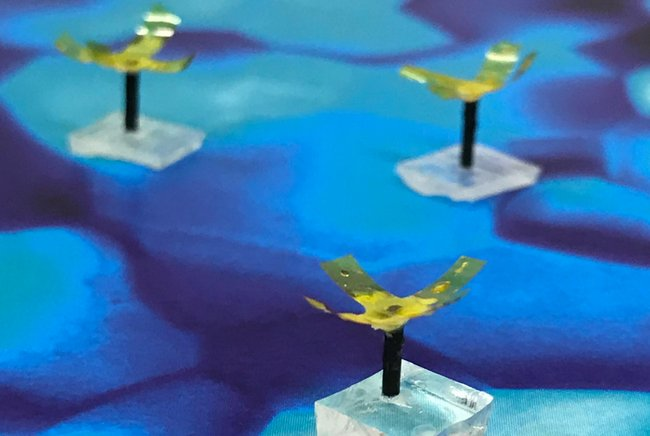Jul 15 2020
A plastic miniature robot, composed of responsive polymers, has been developed by scientists from the Eindhoven University of Technology.
 Inspired by a coral polyp, this plastic mini robot moves by magnetism and light. Image Credit: Eindhoven University of Technology.
Inspired by a coral polyp, this plastic mini robot moves by magnetism and light. Image Credit: Eindhoven University of Technology.
The tiny plastic robot, inspired by a coral polyp, moves under the effect of magnetism and light. In the days to come, this kind of a “wireless aquatic polyp” is expected to pick up and deliver cells for investigation in diagnostic devices, or attract and seize contaminant particles from the surrounding liquid.
The scientists have published the results of their study in the Proceedings of the National Academy of Sciences on July 13th, 2020.
To develop this tiny robot, the scientists took a cue from a coral polyp—a soft and small creature with tentacles, which constitute the corals in the ocean.
Marina Pilz Da Cunha, a doctoral candidate, stated, “I was inspired by the motion of these coral polyps, especially their ability to interact with the environment through self-made currents.”
The stem of the living coral polyps makes a particular movement that produces a current. This current attracts food particles, and the tentacles subsequently grab the floating food particles.
Measuring 1 cm x 1 cm, the newly developed wireless artificial polyp has a stem that responds to magnetism, and to light-steered tentacles.
Combining two different stimuli is rare since it requires delicate material preparation and assembly, but it is interesting for creating untethered robots because it allows for complex shape changes and tasks to be performed.
Marina Pilz Da Cunha, Doctoral Candidate, Eindhoven University of Technology
These tentacles move by illuminating light on them. Different results come from different wavelengths. For instance, the tentacles “grab” under the effect of UV light, while “releasing” with blue light.
From Land to Water
The newly demonstrated device is capable of grabbing and releasing objects underwater, which is a novel trait of the light-guided package delivery mini robot presented by the scientists earlier this year.
The land-based robot is incapable of working underwater, because the polymers constituting that robot act via photothermal effects. In this case, the heat produced by the light powers the robot, rather than the light itself.
Pilz Da Cunha added, “Heat dissipates in water, which makes it impossible to steer the robot under water.” Hence, she created a photomechanical polymer material that moves under the effect of only light and not heat.
The polymer material offers another benefit. In addition to operating underwater, the novel material can maintain its deformation even when it is stimulated by light. Although the photothermal material instantly comes back to its original shape after the removal of the stimuli, the molecules present in the photomechanical material actually assume a new state. This makes it possible to maintain different stable shapes for an extended period of time.
That helps to control the gripper arm; once something has been captured, the robot can keep holding it until it is addressed by light once again to release it.
Marina Pilz Da Cunha, Doctoral Candidate, Eindhoven University of Technology
Flow Attracts Particles
When a rotating magnet is placed below the robot, the stem revolves around its axis, as shown in the above video. “It was therefore possible to actually move floating objects in the water towards the polyp, in our case oil droplets,” added Pilz Da Cunha.
The location of the tentacles (closed, open, or something in between) was found to have an impact on the fluid flow.
“Computer simulations, with different tentacle positions, eventually helped us to understand and get the movement of the stem exactly right. And to ‘attract’ the oil droplets towards the tentacles,” Pilz Da Cunha explained.
Operation Independent of the Water Composition
The robot works autonomously from the composition of the surrounding liquid, which is an additional benefit. This is considered as unique because hydrogels—the dominant stimuli-responsive material employed in today’s underwater applications—are sensitive to their setting. Hence, hydrogels act differently in polluted water.
Our robot also works in the same way in salt water, or water with contaminants. In fact, in the future the polyp may be able to filter contaminants out of the water by catching them with its tentacles.
Marina Pilz Da Cunha, Doctoral Candidate, Eindhoven University of Technology
Next Step: Swimming Robot
Pilz Da Cunha is presently working on the subsequent step—a series of polyps that can function together. She is hoping to transport particles, where a single polyp travels on a package to the other. Da Cunha’s wish list also includes a swimming robot. Here, she is thinking of biomedical applications, like trapping particular cells.
To realize this, the team still needs to work on the wavelengths to which the material reacts.
“UV light affects cells and the depth of penetration in the human body is limited. In addition, UV light might damage the robot itself, making it less durable. Therefore we want to create a robot that doesn’t need UV light as a stimuli,” Pilz Da Cunha concluded.
The study titled “An Artificial Aquatic Polyp that Wirelessly Attracts, Grasps and Releases Objects” was performed at the Department of Chemical Engineering and Chemistry and the Institute for Complex Molecular Systems of Eindhoven University and Technology.
Journal Reference:
Da Cunha, M. P., et al. (2020) An artificial aquatic polyp that wirelessly attracts, grasps, and releases objects. Proceedings of the National Academy of Sciences. doi.org/10.1073/pnas.2004748117.
Wireless aquatic robot could clean water and transport cells
In this video, the artificial polyp of 1 by 1 cm attracts and grabs the floating oil droplet. The stem moves under the influence of magnetism, it therefore creates a current in the water, which attracts the oil droplet to its tentacles. The tentacles then close around the oil droplet, under the influence of UV light. Blue light can open the tentacles again to release the droplet. Video Credit: Eindhoven University of Technology.